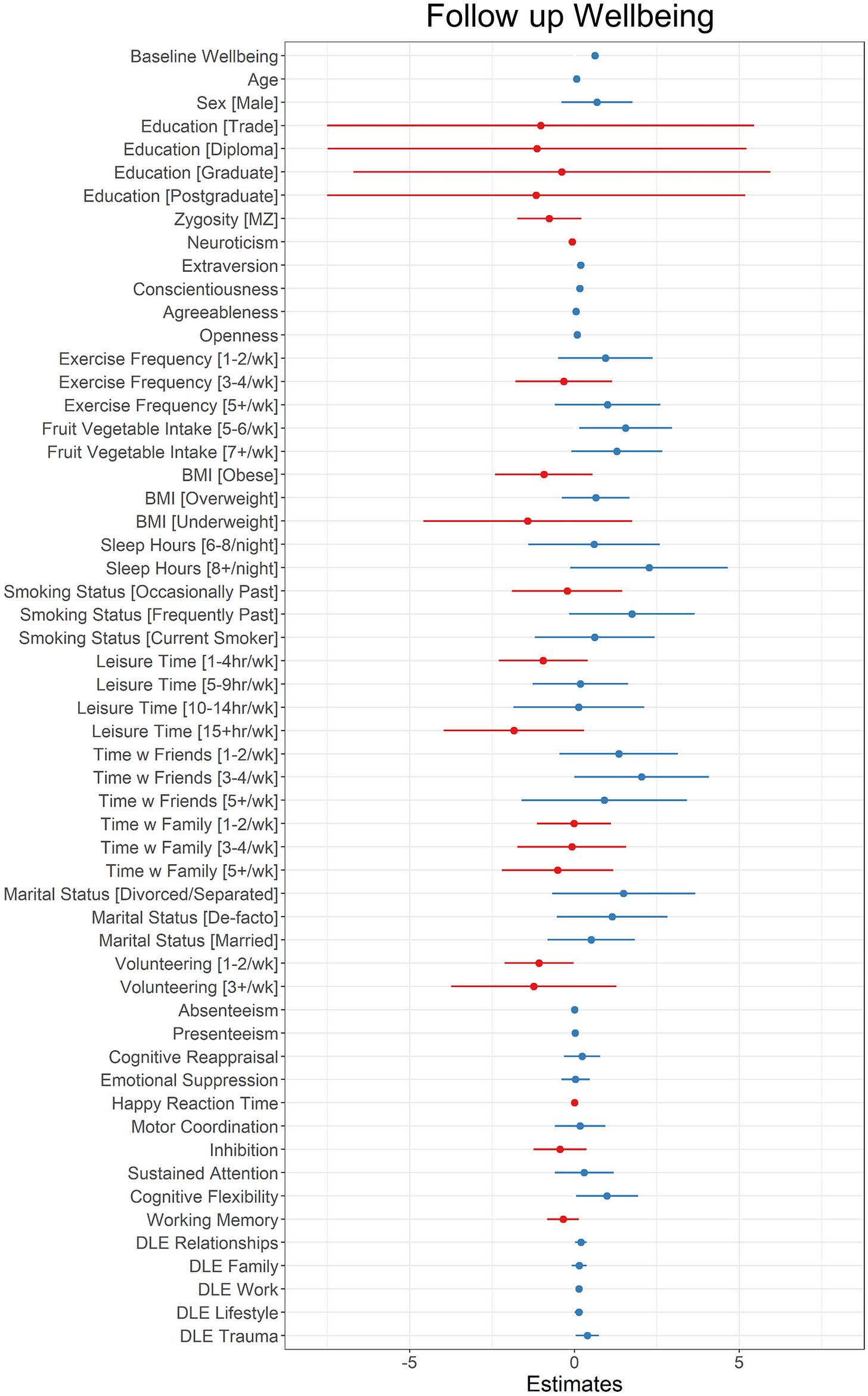Age, partnership, and extraversion are strongly linked to mental wellbeing
Insights from a large-scale Australian study

The Bathers by Amy Sherald. 2015, Oil on canvas. 74 x 72 in. © Amy Sherald. Sherald’s work is showing at SFMOMA until March 9, 2025.Mental well-being is shaped by both subjective factors (life satisfaction, positive emotions) and psychological factors (sense of purpose, control). A recent study, published in Nature Scientific Reports (2023), sheds light on what influences both current and future mental health.
The study analyzed data from 1,017 participants over an average of 15.7 months, exploring a boatload of factors affecting mental wellbeing (see graph below), using both snapshots (cross-sectional) and long-term tracking (longitudinal).
Understanding the graph
When analyzing the graph, focus on the confidence intervals (CIs). If the CI doesn't cross zero, the factor likely has a real effect. Narrow CIs are more reliable, while wider CIs indicate more uncertainty. Blue indicates a positive relationship (e.g., extraversion and better wellbeing), and red shows a negative relationship (e.g., neuroticism and lower wellbeing).

Unstandardised coefficients and 95% confidence interval limits for the final repeated measures model. Blue lines indicate positive coefficients and red lines indicate negative coefficients. Education reference level is High School education; Zygosity reference level is DZ, Marital Status reference level is Single, BMI reference level is Healthy, all other ordinal variable reference levels are “Never” or the lowest level measured. DLE=Daily life events.Key Findings
Mental wellbeing follows a complex pattern as we age. It tends to slightly increase from the mid-30s to 40s, dip slightly in the 40s to 50s, and rise again after age 50, peaking around age 65.
Marital status strongly influences wellbeing. Married individuals reported higher wellbeing than those who were divorced, separated, or single. People in de facto relationships (living together without being married) also had better wellbeing than single people.
A person’s “baseline” or starting point—how well they are doing at the beginning—was the most significant predictor of changes in wellbeing over the following year. Those who started with higher wellbeing were more likely to experience less of a decline.
More extroverted individuals (those who are sociable and outgoing) showed a noticeable improvement in wellbeing over the year compared to others.
Major life events—whether positive (e.g., a rewarding work experience) or negative (e.g., job loss)—can boost or decrease wellbeing. The key is how we perceive these events.
Regular exercise, being conscientious (organized and responsible), engaging in leisure activities, and eating more fruits and vegetables all contributed positively to wellbeing, though their impact was smaller than extraversion.
Leisure activities, like reading, volunteering, and spending time with loved ones, provide opportunities for intrinsic motivation, personal growth, and social connection, fostering a sense of purpose and mastery.
Study limitations
The study didn’t account for life events before the baseline measurement and only used two rounds of data, limiting the ability to track long-term trends or account for measurement error.
Takeaways
→ Extraversion was the strongest predictor of wellbeing changes over the year.
→ How you perceive life events—positive or negative—affects your mental wellbeing more than the events themselves.
→ Regular exercise and eating fruits and vegetables help improve wellbeing.
How to be more extraverted (for your wellbeing)
A 2019 study by UC Riverside researcher Sonja Lyubomirsky found that acting more extraverted improved well-being.
In the study, 123 college students were asked to spend a week behaving in extraverted ways that were talkative, assertive, and spontaneous. The following week, they switched gears and adopted more introverted behaviors— being deliberate, quiet, and reserved.
The results?
Those who acted as extraverts reported higher levels of well-being, while those who embraced introversion felt a dip in their happiness. The best part? Participants didn’t experience any discomfort from adopting the “forced extraversion” and reported improved mental health as a result.
Here’s how to behave more extraverted:
Start conversations. Don’t wait for others to make the first move. Take the initiative to start conversations—whether it’s with a colleague, a friend, or even a stranger. Share your thoughts, experiences, or just ask someone how their day is going. Go beyond the “hi” to your neighbor.
Lead social situations. Whether you’re at work or at a social event, practice being assertive with respect and kindness. Step up to make decisions, offer ideas, or organize plans. By taking charge, you may not only feel more confident, but you may also spark more dynamic and rewarding social interactions.
Embrace spontaneity. Break out of your comfort zone and embrace impromptu opportunities. Whether it’s joining a last-minute gathering or trying something new on the fly, saying “yes” to the unexpected can create meaningful and enjoyable experiences.




